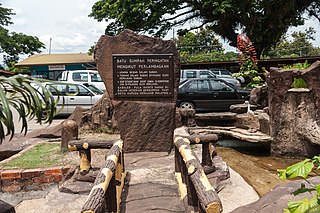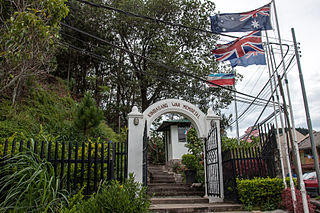
Kota Kinabalu, colloquially referred to as KK, is the state capital of Sabah, Malaysia. It is also the capital of the Kota Kinabalu District as well as the West Coast Division of Sabah. The city is located on the northwest coast of Borneo facing the South China Sea. The Tunku Abdul Rahman National Park lies to its west and Mount Kinabalu, which gave the city its name, is located to its east. Kota Kinabalu has a population of 452,058 according to the 2010 census; when the adjacent Penampang and Tuaran districts are included, the metro area has a combined population of 628,725. The 2020 Census revealed an increase in the municipal population to 500,421, while the wider area including the Penampang and Putatan districts had a population of 731,406.

The Ranau District is an administrative district in the Malaysian state of Sabah, part of the West Coast Division which includes the districts of Kota Belud, Kota Kinabalu, Papar, Penampang, Putatan, Ranau and Tuaran. The capital of the district is in Ranau Town. The landlocked district bordering the Sandakan Division to the east until it meets the Interior Division border. Ranau sits 108 km (67 mi) east of Kota Kinabalu and 227 km (141 mi) west of Sandakan. As of the 2010 Census, the population of the district was 94,092, an almost entirely Dusun ethnic community.

Tawau Airport is an airport located 15 nautical miles north east of Tawau, Sabah, Malaysia. It is one of two airports in Sabah with immigration counters for international flights, the other being Kota Kinabalu International Airport.

The Petagas War Memorial or Petagas War Memorial Garden is a memorial park dedicated to the Second World War victims in Sabah particularly to 324 resistance movement members, who were executed on 21 January 1944 at the site by the Japanese occupying forces of North Borneo for their involvement in the Jesselton Revolt. The park memorial plate lists the names of men of various ethnic groups in North Borneo and from various islands in the Sulu Archipelago including the main resistance leader Albert Kwok and those who assisted or died in Labuan Military Prison. The park was built exactly on the site where the massacre took place and where the victims were initially buried. It is located in Kampung Peringatan Petagas in the district of Putatan in Sabah, Malaysia.

The Double Six Monument is a memorial located at the Sembulan neighbourhood of Kota Kinabalu, Sabah, Malaysia which marks the site of 6 June 1976 fatal plane crash known as the Double Six Tragedy bearing the first Chief Minister of Sabah, Tun Fuad Stephens, as well as six other State ministers.

The history of Sabah can be traced back to about 23–30,000 years ago when evidence suggests the earliest human settlement in the region existed. The history is interwoven with the history of Brunei and the history of Malaysia, which Sabah was previously part of and is currently part of respectively. The earliest recorded history of Sabah being part of any organised civilisation began in the early 15th century during the thriving era of the Sultanate of Brunei. Prior to this, early inhabitants of the land lived in predominantly tribal societies, although such tribal societies had continued to exist until the 1900s. The eastern part of Sabah was ceded to the Sultan of Sulu by the Sultan of Brunei in 1658 for the former helping a victory over Brunei enemies, but many sources stated it had not been ceded at all. By the late 19th century, both territories previously owned by Sultan of Brunei and Sultan of Sulu was granted to British syndicate and later emerged as British North Borneo under the management of the North Borneo Chartered Company. Sabah became a protectorate of the United Kingdom in 1888 and subsequently became a Crown colony from 1946 until 1963, during which time it was known as Crown Colony of North Borneo. On 16 September 1963, Sabah merged with Malaya, Sarawak and Singapore to form Malaysia.

The Keningau Oath Stone is a monument in Keningau, Sabah which was specially erected to commemorate the merger of the British Crown Colony of North Borneo with the former colony of Sarawak and states of the Federation of Malaya to form Malaysia.

The Atkinson Clock Tower is the oldest standing structure in Kota Kinabalu. It was originally known as the Atkinson Memorial Clock Tower and sits in solitary on the bluff along Signal Hill Road overlooking this seaside city and capital of Sabah, Malaysia.

Kota Kinabalu High School, KKHS is a high school in Kota Kinabalu, Sabah, Malaysia.

Kinabalu Tower, also known as Sabah State Administrative Centre is a 33-storey, 182-meter-tall, government office complex building in Kota Kinabalu, Sabah, Malaysia. It is Kota Kinabalu and Borneo's second tallest building.

The North Borneo War Monument is a monument that was erected on 8 May 1923 by the North Borneo Chartered Company in Bond Street, Jesselton, British North Borneo. Originally, it was a memorial for the fallen British soldiers in World War I but later extended to include the Australian soldiers in World War II. The monument stands today in the city park of Kota Kinabalu, the capital of the Malaysian state of Sabah.

The Kundasang War Memorial is a memorial located in Kundasang in the Malaysian state of Sabah, which is dedicated to the British and Australian soldiers who died in the Sandakan POW camp during their death marches to Ranau. Besides that, it also recognises the suffering and sacrifice of the native population of Sabah.

The Starcevich Monument or Beaufort Australian Monument is a monument in the town of Beaufort in Sabah, Malaysia dedicated to Tom Starcevich from the 9th Division Army of Australia during the reconquest of the town by the Allied forces on 28 June 1945.

Sandakan Massacre Memorial consists of three monuments which commemorate 30 Chinese victims, most of the members are local elite of an underground movement who been executed on 27 May 1945 along with several other victims during the Japanese occupation of North Borneo. The memorial was built on the spot where the massacre took place and where the victims were buried. It is located near a Chinese cemetery on a hill above the old town centre of Sandakan.

Cho Huan Lai Memorial or also known as Keningau War Memorial in the Malaysian town of Keningau in Sabah is a monument dedicated to Chinese Consul General Cho Huan Lai and his colleagues who died on 6 July 1945 after being executed by the Japanese.

The Gaya Street is a street Sunday market area in Kota Kinabalu, Sabah, Malaysia. It is known as the Chinatown of Sabah due to many Chinese coffee shops and restaurants situated there. In addition with an arch gate that was erected since 2005.

The Penampang District is an administrative district in the Malaysian state of Sabah, part of the West Coast Division which includes the districts of Kota Belud, Kota Kinabalu, Papar, Penampang, Putatan, Ranau and Tuaran. The capital of the district is in Penampang Town.

Merdeka Square is a square located in Kota Kinabalu, Sabah, Malaysia. The square has a capacity of around 5,000.





















